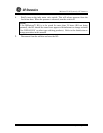
M
Millenium™ RO System by GE Osmonics
14693e - 31 Mar 03 4- 3 Routine Maintenance
4.1 Routine Maintenance of Millenium™ RO System
GE Osmonics Millenium™ RO systems have been designed to operate with a minimum
of operator attention. Like all mechanical systems they will operate longer and with less
trouble when operator maintenance is performed regularly. Operator maintenance on a
GE Osmonics reverse osmosis system is limited to maintaining performance logs,
cleaning and disinfection, replacement of damaged or failed parts and periodic
lubrication. The maintenance procedures have been categorized by their frequency of
action and are as follows:
NOTE:
The first part of this section provides the timelines and simple instructions for
maintenance of your RO. The specific instructions and procedures for the more
complex maintenance items are provided in the second part of this section.
WARNING:
Prior to performing any electrical maintenance unplug the RO power cord from the
wall receptacle.
4.1.1 Daily Maintenance
1. Test and record the hardness level of the feed water in the pretreatment log.
2. Observe and record salt level in the brine tank (for systems with water softener
pretreatment).
3. Observe and record the Chlorine/Chloramine concentrations in the pretreatment
log. Follow the instructions included with each test kit.
WARNING:
Take corrective action or contact your local service representative if any optional
pretreatment device fails to provide adequate treatment of feed water before
continuing with the use of the RO unit.
4. If you are using cartridge pre-filters with your Millenium™, observe and record
the pre-filter inlet and outlet pressure gauges on the operation log. The difference
in the pressure values will help measure the condition of the filter cartridge.
When the pressure differential (delta P) increases 8 PSI above the clean, initial
delta P, the cartridges need to be changed (or sooner if the pre-filter core appears
soiled). To change the pre-filter, the water supply must be turned off. The pre-
filter inlet and outlet gauges should read zero PSI. The pre-filter bowl can now be
removed by rotating it clockwise. Remove the old filter, install the new filter and
re-install the filter bowl.
5. Observe and record the percent rejection and TDS water quality readings in the
operation log.


















